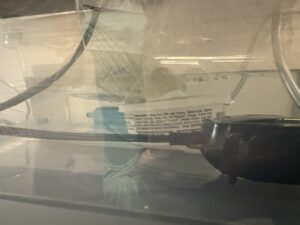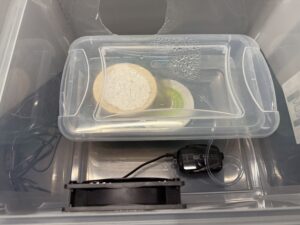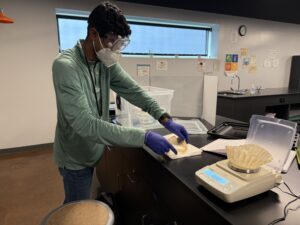May the Carbon Capture be with You!
Tanay N -
Before I get into this week’s blog post, I hope you enjoyed the little Star Was reference! This week has been the most exciting by far, and I’m thrilled to walk you all through it! Additionally, I’ve renamed Lemon to Aether (the Greek God of Air).
Aether’s First Tests: A Major Challenge
On Tuesday March 25th, I started Aether’s first cycle. Each cycle runs for about 24 hours on 5 grams of Calcium hydroxide. The below images show how it looked the next day, March 26th. As you can see, the sides of the coffee filter had been completely submerged in the water. Luckily, no base had touched the water, so the unit was chemically non-hazardous.


However, since the sides of the coffee filter were wet, we could not weigh it. This means we would have to wait another 24 hours for it to dry. This is a major challenge, as Calcium hydroxide naturally absorbs CO2 (just by sitting out), so this will most definitely lead to experimental error. Attached below are some images of me with PPE during the process of transferring the experimental product.

To combat the problem of having to dry the coffee filter, we had to first focus on the causes. This was occurring because the platform was not stable, and the lid the coffee filter was resting on was smaller in diameter than the coffee filter itself.
The Solution
Fortunately, there was an easy fix. I used a beaker filled with water as the main platform. This was very stable and mimics a glass of water found in most homes (staying consistent with the accessibility theme of this project). Ms. Holtzman also graciously offered her lunch container’s lid. The lid worked perfectly, as it was much bigger than the coffee filter, so there was no future risk of the product getting wet.
So we ran the cycle again. Our first test had the fan blowing air outside the unit, so we set it up the same way once more. The images below show the new setup (you can’t see the beaker because the light is refracting in such a way that the glass is invisible, but it’s there).

First Test Results
On Thursday March 27th, we weighed out the first test along with the second test with the more stable setup. The first test captured more CO2 (1.3g for the first test compared with 0.89g from the second test), but I suspect this was because we left it out to dry for an extra 24 hours. To see exactly how much CO2 was captured just by drying, we let the second test sit out for an extra 24 hours as well. After weighing it out on Friday March 28th, my suspicion was proved wrong (the total CO2 captured for the second test was 0.94g). Turns out, the drying only captures 0.05g more of CO2. This means that the newer setup with the larger lid actually decreased the rate of CO2 capture (this makes sense, because the larger lid would block CO2 from getting to and reacting with the Calcium hydroxide).
Major Success!
Fortunately, on March 27th, I ran a new cycle with the fan blowing air inside the unit. On Friday March 28th, we had a yield percentage that was almost 3x the 1st test, totaling 3.1g CO2 captured (and this was without sitting out for 24 hours)!! I wanted to reveal the actual numbers during my final presentation, but this was too exciting not to share with you all.
Future Tests
To confirm these results, I want to run this cycle again. Future tests involve looking at a capture rate curve along a 24 hour period to see if the Calcium hydroxide ever gets saturated by CO2 uptake. If saturation like this does exist, then maybe I can do more tests with the Calcium hydroxide more spread out in the coffee filter (currently it’s all clumped in the center). Today I also plan on running it with an incense stick to sort of mimic putting these units in “steam stacks” or temporarily high CO2 density areas. Although CO2 does diffuse evenly throughout the atmosphere over time, places with recent fires/heavy pollution have temporarily very high levels of CO2, so I was thinking that this test with the incense stick could demonstrate potential scalability and usefulness in different aspects such as providing relief for households from wildfire smoke, etc. This would also be a shorter cycle, because I don’t want to risk any damage to the unit or excess smoke.
As always, let me know if you have any questions or would like to suggest other experimental setups for Aether. Once again, I’d like to thank Ms. Holtzman, Mr. Ryan (ASU), and Dr. Green (ASU) for their guidance in the school lab or at the Center for Negative Carbon Emissions.
In my next blog post, I’ll go into what I’ve been doing in the lab and what I’ve learned so far. I’m so very grateful for you all taking the time to read through my journey and I’m excited for what’s to come in these final couple of weeks! 🙂



Comments:
All viewpoints are welcome but profane, threatening, disrespectful, or harassing comments will not be tolerated and are subject to moderation up to, and including, full deletion.